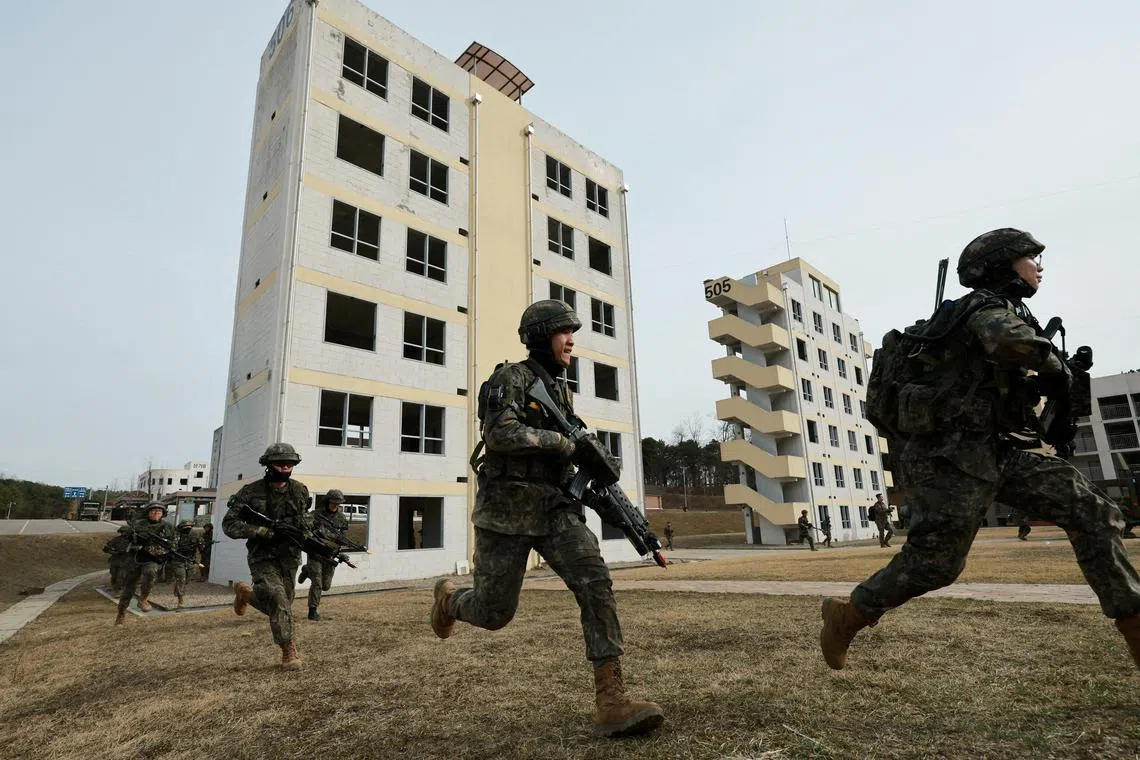US, South Korea start live-fire drills set to anger Pyongyang
Sign up now: Get insights on Asia's fast-moving developments

South Korean soldiers take part in a joint military drill with the US near the border with North Korea on March 16.
PHOTO: REUTERS
Follow topic:
SEOUL – United States and South Korean forces began their largest-ever live-fire drills on Thursday, simulating a “full-scale attack” from North Korea, said the South’s Defence Ministry.
The drills are taking place less than 40km from the border, and are the start of training that runs through June 15. The exercises are expected to include advanced weaponry and drones to better prepare the two allies to work together against North Korea as it ramps up its provocations, South Korea’s military said.
Some 2,500 troops from the South and the US took part as the five-day exercise began in Pocheon, said South Korea’s Defence Ministry said.
Multiple tanks, howitzers and fighter jets were also involved, it said.
“The exercise demonstrated our military’s capability and readiness to strongly respond to North Korea’s nuclear and missile threats, and to a full-scale attack,” the ministry said in a news release.
Last week, North Korea’s state media reported that leader Kim Jong Un had approved final preparations for the launch of the country’s first military spy satellite.
Mr Kim has said it is necessary to counter threats from the US and South Korea.
Analysts say the satellite will improve North Korea’s surveillance capability, enabling it to strike targets more accurately in the event of war.
Recent commercial satellite imagery showed progress on a new launch pad in the North’s satellite launching station, with activity at a “new level of urgency”, most likely in preparation for the launch, the US-based monitoring group 38 North said.
The drills add to the display of force by South Korea and the US as they mark the 70th anniversary of an alliance forged during the Korean War.
The two allies have been carrying out various exercises in recent months, including air and sea drills involving US B-1B bombers, after hopes for diplomatic efforts and Covid-19 restrictions led to many drills being scaled back.
North Korea has reacted angrily to the drills, which it sees as preparation by US and South Korean forces for an invasion.
Additional cooperation is expected to come after South Korean President Yoon Suk-yeol and US President Joe Biden agreed in April on a plan for the US to keep deploying nuclear assets
Mr Yoon, who took office a year ago, has worked to restore joint drills with the US that had been suspended or scaled back under his predecessor Moon Jae-in and former US president Donald Trump, as they sought a rapprochement with Pyongyang.
Those efforts resulted in three face-to-face meetings between Trump and Mr Kim, but no concrete steps to reduce North Korea’s atomic arsenal – which only grew larger as talks fizzled.
After starting the year firing off rockets at a blistering pace, Mr Kim’s regime has not launched a ballistic missile for more than a month.
But the last one marked a major development for the country’s programme, with the test launch of its first solid-fuel intercontinental ballistic missile (ICBM),
The country’s current ICBM inventory comprises liquid-fuel rockets, which take more time to prepare and fill with propellant, opening a window of vulnerability for them to be shot on the pad before taking off.
North Korea has rolled out a variety of new solid-fuel ballistic missiles over the past few years designed to strike South Korea and Japan, which together host the bulk of America’s military personnel in the region. REUTERS, Bloomberg

